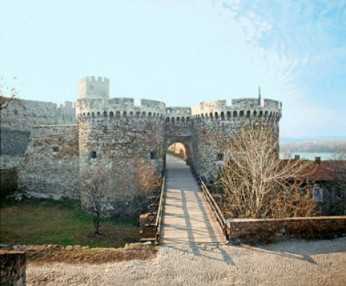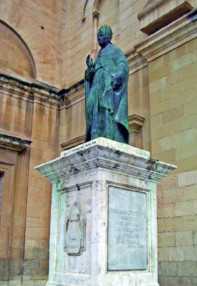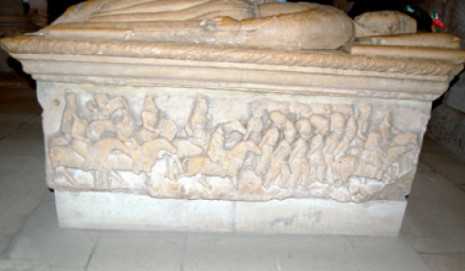What Has Not Been Written About Before
Szöveg: hungariandefence.com | 2011. július 24. 6:01The history of the noon bell has already been the topic of many publications. The readers of the bilingual (English–Hungarian) book “The Noon Bell in Hungary and the World”, – which has recently been released by Zrínyi Média – can now find a great wealth of heretofore unpublished interesting details in it. Without intending to be exhaustive, below are a number of excerpts from the book.

the forts of Southeastern Europe. Its history in
the last two millennia became intertwined with
the life of European countries and nations, and
often changed the course of their history.
Strategically, the fortress was built at a very
advantageous location, at the intersection of
roads leading to the East. It served as a stronghold
for centuries, but on a few occasions it was also
the starting point for campaigns of conquest. In
addition to its favorable geographical location,
the features of the terrain also facilitated the
establishment of a settlement and a fortress. The
hill above the confluence of the Danube and
Sava with a plateau on it provided ideal natural
conditions for defense. It was surrounded by
rivers on three sides that were accessible through
steep slopes and rocks on the hillside. The southeastern
side was the only one that offered easy
access to the castle. Lying 50 meters above the
river on top of the hill, the plateau commanded
the whole area around it. The rocky soil covered
with a layer of loess favored the construction of
stable walls.
Thanks to historical and archaeological research,
we know the history of the development
of the Belgrade forts, which went on for centuries.
Fragmentary remains of the oldest one, the
Roman castrum were excavated in the area of
today’s Tvrđava (castle) and Kalemegdan Park.
This stone-built stronghold was set up at the turn
of the 2nd and 3rd centuries. It was destroyed several
times, but survived in a restored form until
the beginning of the 7th century, when the attacks
of the Avars and the Slavs demolished it for good.
The first walls of the medieval fort were built
on the hill above the confluence of the Danube
fenntarand
the Sava. They functioned as Byzantine
forts (castellum) during the fights that took place
in areas bordering Hungary. Later, several new
buildings were put up around the relatively small
fort. In the 1340s, when Belgrade was temporarily
under the rule of Stefan Dušan, the king of
Serbia, a section of the bank of the Sava was
surrounded by a castle wall, which was connected
to the fort on the plateau. Thus, the site could be
defended more effectively against attacks
launched from the riverside. Nevertheless, this
and the subsequent attempts to build a new fort
at the northern border of the country all failed
because the Hungarians soon recaptured the
city they had lost. (…)
The Pope of Nándorfehérvár:
Callixtus III

generally know only a little about Pope
Callixtus III (1455–1458), who paved the way for
the Nándorfehérvár victory with bell-ringing
and prayer, and later ordered the Feast of the
Transfiguration to commemorate the event.
After being elected pope at an advanced age as a
member of the influential Spanish Borgia/Borja
family, he brought many of his relatives to Rome
and ordained his infamous nephew – who later
became Pope Alexander VI (1492–1503) – as a
cardinal; being a Renaissance pope, he supported
his relatives. He took action against the Ottoman
expansion but was unable to achieve any significant
results during his short reign. However,
this does not answer the question as to why his
overriding aim was to provide protection against
the threat coming from the east. The details of
his long life give us the answer.
Alfonso Borja (Borgia), of Catalan origin, was
born on December 31, 1378 in Xativa, near Valencia;
his father was a smallholder. Valencia did
not have a university at that time, so Alfonso
took degrees in secular and canon law at the
faculty of law of the University of Lerida, where
he became a professor. Avignon Antipope
Benedict XIII (1394–1417), known as Pedro de
Luna by his original name, ordained him as a
canon, and he entered the service of King
Alfonso V of Aragon (1416–1458). After 1423,
the death of Benedict XIII (deposed in 1417), a
new antipope, Clement VIII (1423–1429) was
elected, who was supported by Alfonso V in his
rivalry with Martin V (1417–1431), the legal
pope.
Being a skilful diplomat, Alfonso de Borja
reconciled his king with the Pope in Rome, who
appointed him bishop of Valencia in 1429. Borja
tried to mediate between Aragon and Castile,
and his overtures to the Kingdom of Naples were
followed by the military victory of the sovereign
(1442). It was a natural conclusion that Alfonso
V entrusted him with conducting negotiations
with Cardinal Scarampo. (…)
John Hunyadi’s tomb
in the Cathedral of
Gyulafehérvár

plague that broke out after the Nándorfehérvár
victory, and was buried in the episcopal cathedral
of Gyulafehérvár (now Alba Iulia, Romania) in
Transylvania.
On his visit to the cathedral of Gyulafehérvár
in 1816, Ferenc Kazinczy (1759–1831), the initiator
of modern Hungarian literary life gave a
touching description of the tomb of the three
Hunyadis – John and his son, László (Ladislas),
and the younger John. In comparison with Kazinczy’s
description, the layout of the three
sepulchers has hardly changed. Until the restoration
that began in 1967, those entering the
cathedral saw the same as Kazinczy did. During
the restoration, the sarcophagi were dissembled
and following their reassembly, the end slabs –
since they did not belong to the Hunyadi sepulcher
– were inserted into the walls of the
church.
It was revealed by the end of the 19th century
that the group of three Hunyadi sarcophagi had
a layout that was created subsequently, and the
two most important ones, that of the governor
and his son Ladislas, were in fact pasticcio, being
related to John Hunyadi in a very peculiar way.
The sepulchers of the cathedral were looted and
broken on a number of occasions during the
Ottoman incursions. The tombs of John and
Ladislas Hunyadi were probably united in the
late 17th century – when the tomb of John the
younger was also placed next to them –, and it
was even later, in the middle of the 18th century
that they were transferred to the southern aisle,
where they can be found today.
What can we see on the three Hunyadi tombs
today? The earliest sarcophagus was carved out
of a single piece of stone, so there can be no
doubt that its components belong together. The
inscription tells us that the deceased man is John
Hunyadi the younger, called miles. It is a fact that
the governor had a younger brother who died at
a young age in 1440 and had the same first
name.
Today the middle sarcophagus consists of
three reliefs. The male figure on the cover slab
holds a commander’s rod in his right, and rests
his left hand on his saber. There is a pillow under
his head, with the text IOHANNES HV|NYADI
CORVIN(us) engraved on it at a later time. This
makes it clear that this is the sepulcher of John
Hunyadi. The reliefs on the side slabs were
described by Kazinczy in detail: on one of them
we can see fighting horsemen (figure 20), and on
the other the taking away of captives.
The third sepulcher – which has been left to us
as the sarcophagus of Ladislas Hunyadi – has
only a cover slab today, with the figure of a
mantled, armored warrior lying on it. The
secondary text is engraved on the stomach of a
lion that lies at his feet: LAD[IS]L: HVNYA |
CORV[…]. The warrior is surrounded by two
angels holding coats of arms: the angel on his
right raises the coat of arms of the Hunyadis,
while the one on his left holds a coat of arms
with a wolf (the heraldic beast of the Szapolyais)
emerging from a triple mound. (…)
You can find further interesting details in the book “The Noon Bell in Hungary and the World", which is available at Zrínyi Média (H-1087 Budapest, Kerepesi út 29/B) or may be downloaded from the Zrínyi Média Digital Library.